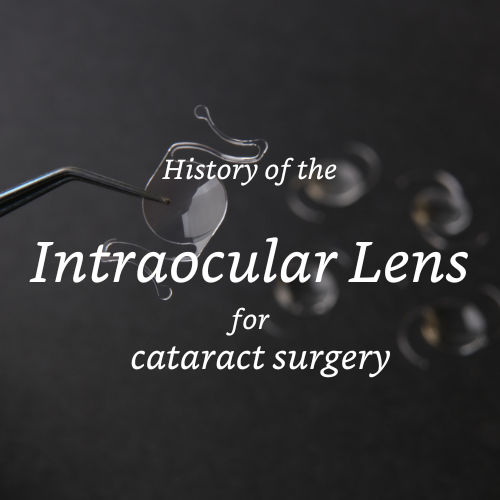History of the Intraocular Lens


The intraocular lens was first introduced by the French ophthalmologist Jacques Daviel in the 18th century. In 1747, Daviel performed the first successful extracapsular cataract extraction surgery, which involved removing the cloudy lens of the eye through a small incision in the cornea. However, he recognized that removing the natural lens left the eye without the ability to focus light, resulting in a significant loss of vision.
To address this problem, Daviel proposed the idea of replacing the natural lens with an artificial one made of glass or other transparent material. He suggested that the artificial lens could be inserted into the eye after the natural lens was removed, restoring the eye’s ability to focus light and improving visual acuity.
While Daviel’s idea was ahead of its time, the technology and materials needed to develop a practical IOL were not yet available. It was not until the mid-20th century that Harold Ridley successfully implanted the first IOL made of a biocompatible material, paving the way for modern cataract surgery and the widespread use of IOLs.
20th Century Developments
In 1949, a British ophthalmologist named Harold Ridley observed that injured World War II pilots who had acrylic plastic splinters in their eyes did not experience any adverse reactions from the material. This observation led him to propose the idea of using a plastic lens to replace the natural lens of the eye.
Ridley developed the first intraocular lens made of polymethyl methacrylate (PMMA) plastic in 1949. The lens was implanted in a patient’s eye in 1950, and the procedure was successful. However, Ridley faced significant opposition from the medical community, who were skeptical of the long-term safety and efficacy of the procedure.
Ridley’s initial attempts to promote the use of IOLs were met with skepticism and opposition from many of his colleagues, who felt that the risks outweighed the potential benefits. Some of his critics went so far as to call him a “madman” and a “charlatan.”
Despite the opposition, Ridley was determined to prove the safety and efficacy of the IOL. He performed the first successful implantation of an IOL in a patient in 1950, and over the next several years, he continued to refine the procedure and develop new types of lenses.
Intraocular Lens Gains Acceptance
It wasn’t until the 1970s that IOLs gained wider acceptance in the medical community, following the development of foldable IOLs that could be implanted through smaller incisions. This made the procedure less invasive and reduced the risk of complications.
Today, IOLs are a common and safe treatment for cataracts, a condition that causes clouding of the natural lens of the eye. They are also used in some cases to correct refractive errors, such as nearsightedness, farsightedness, and astigmatism. There are various types of IOLs available, including monofocal lenses, multifocal lenses, and toric lenses, each designed to meet the specific needs of individual patients.
Advanced Intraocular Lenses
Today’s advanced intraocular lenses (IOLs) are designed to provide patients with a range of benefits beyond simply restoring clear vision after cataract surgery. Here are some of the features and benefits of advanced IOLs:
Multifocal IOLs: These lenses are designed to provide clear vision at multiple distances, allowing patients to see clearly both up close and far away without the need for glasses. Multifocal IOLs use a series of rings or zones with different focusing powers to allow patients to see clearly at different distances.
Accommodating IOLs: These lenses are designed to mimic the natural focusing ability of the eye, allowing patients to see clearly at multiple distances without the need for glasses. Accommodating IOLs use a flexible design that allows the lens to move slightly within the eye to adjust focus, much like the natural lens of the eye.
Toric IOLs: These lenses are designed to correct astigmatism, a condition that causes distorted or blurred vision due to an irregularly shaped cornea. Toric IOLs have a special shape that corrects the corneal shape, allowing for clear vision without the need for glasses.
Extended Depth of Focus (EDOF) IOLs: These lenses are designed to provide an extended range of clear vision, with a gradual shift from distance to intermediate and near vision. EDOF IOLs use a series of diffractive rings to create a continuous range of focus, providing clear vision at multiple distances.
Blue-light-filtering IOLs: These lenses are designed to filter out blue light, which has been shown to contribute to retinal damage over time. Blue-light-filtering IOLs can help protect the eye from long-term damage and improve visual comfort.
Overall, advanced IOLs offer patients a range of options for restoring clear vision after cataract surgery and can help reduce or eliminate the need for glasses or contact lenses. Your ophthalmologist can help determine which type of IOL is best suited for your individual needs and preferences.
Gregory Scimeca, M.D.
Ophthalmologist and Medical Director
The Eye Professionals
Our Locations
